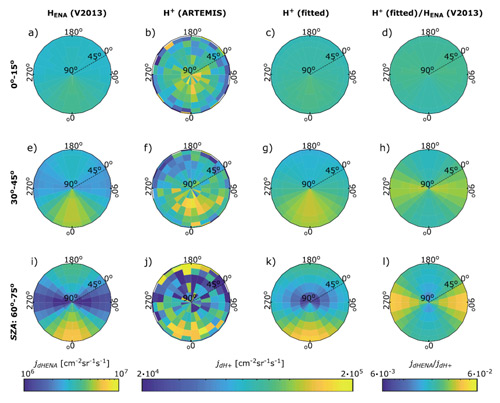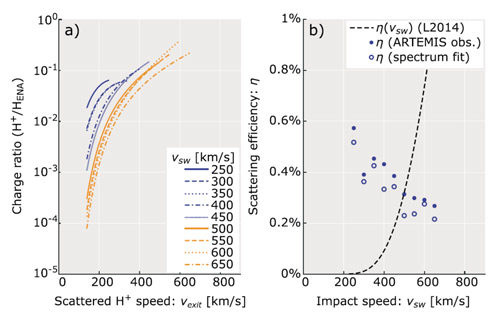2018 ARTEMIS SCIENCE NUGGETS
ARTEMIS observations of solar wind proton scattering off the lunar surface
by C. Lue
Swedish Institute of Space Physics
Introduction
The dayside surface of the Moon is exposed to protons coming from the Sun, as part of the solar wind. The protons engage in a range of interaction processes with the lunar surface dust. These processes affect both the surface evolution and the environment of the Moon. In the interaction, the protons may either become absorbed by the surface or scattered back into the lunar space environment. While most of the scattered protons capture an electron at the surface and leave as neutral hydrogen atoms, some retain their positive charge and embark on spiraling trajectories as they encounter the surrounding solar wind flow. As a step toward a better understanding of the scattering process, in this study we have looked closer at statistical properties of protons scattered at the lunar surface. The studied properties are the scattered proton energy spectrum, the directional scattering distribution, and the scattering efficiency.
| Figure 1. Energy spectra of surface-scattered solar wind particles, for different impact speeds (vsw). The dashed lines represent an empirical model for scattered neutralized hydrogen atoms (Futaana et al., 2012). The dotted lines represent an earlier empirical model for scattered protons (Lue et al., 2014). The blue dots show the ARTEMIS observations, and the solid line shows the new empirical model for scattered protons. (Figure from Lue et al., 2017) |
Data
For this study (Lue et al., 2017), we used ARTEMIS ion observations and traced the observed ions back to the lunar surface with the help of ARTEMIS magnetic field measurements. Thanks to ARTEMIS’ large data set, collected over several years, we were able to cover a wide range of impact parameters and scattering vectors while maintaining strict data selection criteria to isolate scattered protons from other ion populations in the lunar environment.
| Figure 2. Directional scattering functions of surface-scattered solar wind particles. The 0° azimuth angle at the lower end of each circle indicates the backward-scattering direction, while 180° indicates the forward-scattering direction. The edges of the circles indicate scattering in a direction tangential to the lunar surface, and the 90° elevation angle at the circle centers indicates scattering normal to the lunar surface. Each row corresponds to a different range of incidence angles (SZA). The first column shows an empirical model of scattered neutral hydrogen atoms (Vorburger et al., 2013). The second column shows ARTEMIS observations of scattered protons. The third column shows a fitted scattering model for protons, based on the ARTEMIS observations, and the fourth column shows the difference between the proton and hydrogen models. (Figure from Lue et al., 2017) |
Results
We observed the scattering properties under different impact energies and incidence angles. The energy spectrum of scattered protons (Figure 1) has a peak at a fraction of the impact energy and does not change significantly with incidence angle. The directional scattering function (Figure 2) favors scattering in the direction back towards the Sun. The scattering efficiency (Figure 3b) is ~0.4% and has a negative correlation with the solar wind impact speed (~0.5% at 300 km/s to ~0.3% at 600 km/s), while showing no significant dependence on the incidence angle.
| Figure 3. a) charge-state fractions of surface-scattered solar wind particles versus exit speed (vexit) and impact speed (vsw). b) proton scattering efficiency versus impact speed based on ARTEMIS observations, using two different methods, compared with a very different previous result (Lue et al., 2014). (Figure from Lue et al., 2017) |
Discussion
The favoring of the backward scattering direction likely has to do with the grainy microstructure of the loosely packed surface dust, where the best way out is the way in. This property is also found in previous observations of scattered neutral hydrogen atoms by the Chandrayaan-1 spacecraft (Figure 2), suggesting that protons and neutralized hydrogen atoms are scattered due to the same physical mechanism.
The observed average scattering rate of 0.4% is consistent with previous results based on Kaguya (Saito et al., 2008) and Chandrayaan-1 (Lue et al., 2014) data. However, its negative correlation with impact speed is opposite to the findings by Lue et al. (2014). We discuss in our more recent paper (Lue et al., 2017) that this can be explained by an observation bias in the previous study.
The average energy of scattered protons is higher than that of scattered neutralized hydrogen (Figure 1), suggesting an increased chance for scattered particles to remain positive if they leave the surface with a higher speed. This positive correlation with exit speed is expected from theory and laboratory measurements, as well as previous lunar observations. However, it is quite peculiar then that we found a negative correlation of the scattering efficiency with impact speed, because it implies that the charge state of scattered particles increases with higher exit speeds but at the same time decreases with higher impact speeds (Figure 3a). This seems to indicate that the charge state evolves over the course of the interaction within the regolith and is not determined solely by its speed at the departure from the surface.
Conclusions
We have used our new results to fit empirical models (see Lue et al., 2017) of the proton scattering properties, which can be used to forecast and understand the distribution and fate of protons in the lunar environment. The results show that protons scatter back toward the source just like neutralized hydrogen atoms. The results also show that the scattered particles’ charge states depend partly on the impact speed, which contrasts with previous observations and expectations. This points to a gap in our current understanding of the interaction microphysics between solar wind protons and the lunar regolith, which remains to be resolved by future studies.
References
Lue et al. (2017), ARTEMIS observations of solar wind proton scattering off the lunar surface.Futaana et al. (2012), Empirical energy spectra of neutralized solar wind protons from the lunar regolith.
Vorburger et al. (2013), Energetic neutral atom imaging of the lunar surface.
Saito et al. (2008), Solar wind proton reflection at the lunar surface: Low energy ion measurement by MAP-PACE onboard SELENE (Kaguya).
Lue et al. (2014), Chandrayaan-1 observations of backscattered solar wind protons from the lunar regolith: Dependence on the solar wind speed.
Biographical Note
Charles Lue is currently a Guest Researcher at the Swedish Institute of Space Physics. He worked on this study as a Post-Doctoral Research Scholar at the Department of Physics and Astronomy at the University of Iowa. He has primarily worked with data analysis and has studied the solar wind-Moon interaction using observations from the Chandrayaan-1, Kaguya, and ARTEMIS lunar orbiters and the Chang’E 4/Yutu 2 lunar rover.
 Please send comments/suggestions to
Emmanuel Masongsong / emasongsong @ igpp.ucla.edu
Please send comments/suggestions to
Emmanuel Masongsong / emasongsong @ igpp.ucla.edu


